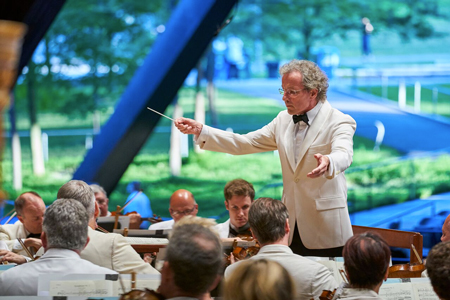by Daniel Hathaway

Milhaud developed a taste for the popular music of Brazil while serving as assistant to French ambassador Paul Claudel in Rio. Le boeuf is a medley of two dozen popular tunes scored for a dance-band orchestra and stitched together by the composer’s own, very Brazilian-sounding ritornello. That recurrent theme visits all twelve major keys, separated by interludes featuring woozy wind writing that makes you suspect that half the orchestra stopped off at the bar for one too many Cachaças beforehand.
The composer conceived Le boeuf as a silent film score, but Jean Cocteau twisted Milhaud’s arm in the direction of a ballet, the form in which the piece was premiered in Paris in 1920 with a surreal plot, a bizarre cast of characters, and slo-mo choreography intentionally out of sync with the jazzy music. That staging would have been fun to see, but The Cleveland Orchestra’s performance of the music was piquant and delightful all on its own. Frank Rosenwein contributed alluring oboe solos to its more lyrical moments.
Though Roussel turned his back on Impressionism and Romanticism after World War I, his Suite No. 2 from Bacchus and Ariadne (the whole second act of the ballet) is sumptuous and evocative.
Asleep on the island of Naxos amid gentle violin and viola solos, Ariadne stirs to little murmurings in the winds to find herself abandoned by Theseus. She frantically goes in search of him, and as the orchestration grows more animated, falls under the spell of Bacchus. A faun and a maenad create wine in a golden goblet, inspiring intoxication and eventually a Bacchanale whipped into a frenzy among ascending brass chords and general orchestral brilliance.
Although some believe that Beethoven symphonies should always sound difficult because of the way the composer pushed the limits of form and orchestral technique, there’s still something wonderful about how effortlessly The Cleveland Orchestra plays them while still keeping the excitement high.
Under Welser-Möst on Saturday evening, the Seventh sounded utterly confident and relaxed, its insistent rhythms perfectly calibrated and its dynamics finely controlled. Some pianissimos — in the first-movement development and at the beginning of the second — may have been at the threshold of audibility for an outdoor venue, but at the other end of the spectrum, loud passages never sounded forced.
Though Beethoven usually likes long goodbyes at the end of movements, this symphony is remarkable for its terse final cadences. He also loves repetition of catchy rhythmic patterns, as fans of the finale of No. 7 already know and appreciate. The three millennials sitting in front of me had a terrific time headbanging to that part of the piece, and a big ovation at the end validated their enthusiasm.
Photo by Roger Mastroianni.
Published on ClevelandClassical.com July 17, 2017.
Click here for a printable copy of this article



